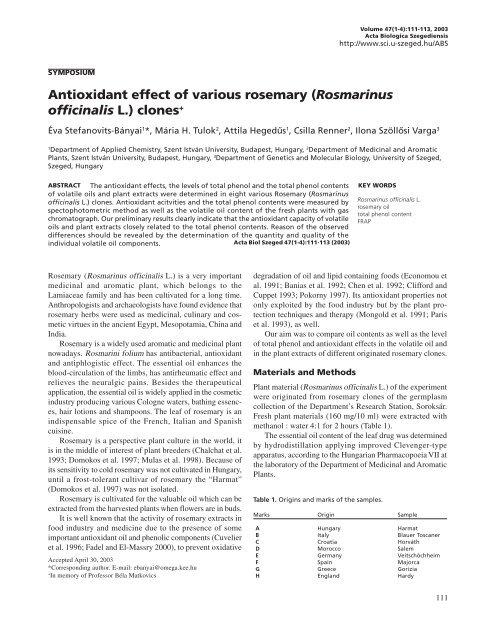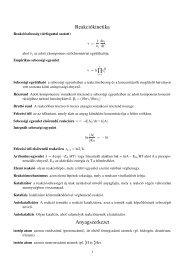Antioxidant effect of various rosemary (Rosmarinus officinalis L ...
Antioxidant effect of various rosemary (Rosmarinus officinalis L ...
Antioxidant effect of various rosemary (Rosmarinus officinalis L ...
Create successful ePaper yourself
Turn your PDF publications into a flip-book with our unique Google optimized e-Paper software.
SYMPOSIUM<br />
<strong>Antioxidant</strong> <strong>effect</strong> <strong>of</strong> <strong>various</strong> <strong>rosemary</strong> (<strong>Rosmarinus</strong><br />
<strong>of</strong>ficinalis L.) clones +<br />
Volume 47(1-4):111-113, 2003<br />
Acta Biologica Szegediensis<br />
http://www.sci.u-szeged.hu/ABS<br />
Éva Stefanovits-Bányai 1 *, Mária H. Tulok 2 , Attila Hegedûs 1 , Csilla Renner 2 , Ilona Szöllôsi Varga 3<br />
1 Department <strong>of</strong> Applied Chemistry, Szent István University, Budapest, Hungary, 2 Department <strong>of</strong> Medicinal and Aromatic<br />
Plants, Szent István University, Budapest, Hungary, 3 Department <strong>of</strong> Genetics and Molecular Biology, University <strong>of</strong> Szeged,<br />
Szeged, Hungary<br />
ABSTRACT The antioxidant <strong>effect</strong>s, the levels <strong>of</strong> total phenol and the total phenol contents<br />
<strong>of</strong> volatile oils and plant extracts were determined in eight <strong>various</strong> Rosemary (<strong>Rosmarinus</strong><br />
<strong>of</strong>ficinalis L.) clones. <strong>Antioxidant</strong> acitvities and the total phenol contents were measured by<br />
spectophotometric method as well as the volatile oil content <strong>of</strong> the fresh plants with gas<br />
chromatograph. Our preliminary results clearly indicate that the antioxidant capacity <strong>of</strong> volatile<br />
oils and plant extracts closely related to the total phenol contents. Reason <strong>of</strong> the observed<br />
differences should be revealed by the determination <strong>of</strong> the quantity and quality <strong>of</strong> the<br />
individual volatile oil components.<br />
Acta Biol Szeged 47(1-4):111-113 (2003)<br />
Rosemary (<strong>Rosmarinus</strong> <strong>of</strong>ficinalis L.) is a very important<br />
medicinal and aromatic plant, which belongs to the<br />
Lamiaceae family and has been cultivated for a long time.<br />
Anthropologists and archaeologists have found evidence that<br />
<strong>rosemary</strong> herbs were used as medicinal, culinary and cosmetic<br />
virtues in the ancient Egypt, Mesopotamia, China and<br />
India.<br />
Rosemary is a widely used aromatic and medicinal plant<br />
nowadays. Rosmarini folium has antibacterial, antioxidant<br />
and antiphlogistic <strong>effect</strong>. The essential oil enhances the<br />
blood-circulation <strong>of</strong> the limbs, has antirheumatic <strong>effect</strong> and<br />
relieves the neuralgic pains. Besides the therapeutical<br />
application, the essential oil is widely applied in the cosmetic<br />
industry producing <strong>various</strong> Cologne waters, bathing essences,<br />
hair lotions and shampoons. The leaf <strong>of</strong> <strong>rosemary</strong> is an<br />
indispensable spice <strong>of</strong> the French, Italian and Spanish<br />
cuisine.<br />
Rosemary is a perspective plant culture in the world, it<br />
is in the middle <strong>of</strong> interest <strong>of</strong> plant breeders (Chalchat et al.<br />
1993; Domokos et al. 1997; Mulas et al. 1998). Because <strong>of</strong><br />
its sensitivity to cold <strong>rosemary</strong> was not cultivated in Hungary,<br />
until a frost-tolerant cultivar <strong>of</strong> <strong>rosemary</strong> the “Harmat”<br />
(Domokos et al. 1997) was not isolated.<br />
Rosemary is cultivated for the valuable oil which can be<br />
extracted from the harvested plants when flowers are in buds.<br />
It is well known that the activity <strong>of</strong> <strong>rosemary</strong> extracts in<br />
food industry and medicine due to the presence <strong>of</strong> some<br />
important antioxidant oil and phenolic components (Cuvelier<br />
et al. 1996; Fadel and El-Massry 2000), to prevent oxidative<br />
Accepted April 30, 2003<br />
*Corresponding author. E-mail: ebanyai@omega.kee.hu<br />
+ In memory <strong>of</strong> Pr<strong>of</strong>essor Béla Matkovics<br />
KEY WORDS<br />
<strong>Rosmarinus</strong> <strong>of</strong>ficinalis L.<br />
<strong>rosemary</strong> oil<br />
total phenol content<br />
FRAP<br />
degradation <strong>of</strong> oil and lipid containing foods (Economou et<br />
al. 1991; Banias et al. 1992; Chen et al. 1992; Clifford and<br />
Cuppet 1993; Pokorny 1997). Its antioxidant properties not<br />
only exploited by the food industry but by the plant protection<br />
techniques and therapy (Mongold et al. 1991; Paris<br />
et al. 1993), as well.<br />
Our aim was to compare oil contents as well as the level<br />
<strong>of</strong> total phenol and antioxidant <strong>effect</strong>s in the volatile oil and<br />
in the plant extracts <strong>of</strong> different originated <strong>rosemary</strong> clones.<br />
Materials and Methods<br />
Plant material (<strong>Rosmarinus</strong> <strong>of</strong>ficinalis L.) <strong>of</strong> the experiment<br />
were originated from <strong>rosemary</strong> clones <strong>of</strong> the germplasm<br />
collection <strong>of</strong> the Department’s Research Station, Soroksár.<br />
Fresh plant materials (160 mg/10 ml) were extracted with<br />
methanol : water 4:1 for 2 hours (Table 1).<br />
The essential oil content <strong>of</strong> the leaf drug was determined<br />
by hydrodistillation applying improved Clevenger-type<br />
apparatus, according to the Hungarian Pharmacopoeia VII at<br />
the laboratory <strong>of</strong> the Department <strong>of</strong> Medicinal and Aromatic<br />
Plants.<br />
Table 1. Origins and marks <strong>of</strong> the samples.<br />
Marks Origin Sample<br />
A Hungary Harmat<br />
B Italy Blauer Toscaner<br />
C Croatia Horváth<br />
D Morocco Salem<br />
E Germany Veitschöchheim<br />
F Spain Majorca<br />
G Greece Gorizia<br />
H England Hardy<br />
111
Stefanovits-Bányai et al.<br />
112<br />
1,5<br />
0,5<br />
2<br />
1<br />
0<br />
Volatile oil<br />
Figure 1. Volatile oil contents (ml/100 g fresh weight) <strong>of</strong> <strong>various</strong><br />
<strong>rosemary</strong> (<strong>Rosmarinus</strong> <strong>of</strong>ficinalis L.) clones.<br />
2000<br />
1500<br />
1000<br />
A<br />
500<br />
0<br />
ml/100g fresh weight<br />
A B C D E F G H<br />
AA mM/L<br />
FRAP<br />
A B C D E F G H<br />
Total soluble phenols were determined using Folin-<br />
Ciocalteu reagent according to the method <strong>of</strong> Singleton and<br />
Rossi (1965). The content <strong>of</strong> soluble phenols was calculated<br />
from a standard curve obtained with different concentrations<br />
<strong>of</strong> gallic acid.<br />
<strong>Antioxidant</strong> power was measured by the FRAP (Ferric<br />
Reducing Ability <strong>of</strong> Plasma) method at λ=593 nm (Benzie<br />
and Strain 1996).<br />
Results and Discussion<br />
Our results are summarized in Figures 1-3. We have found<br />
differences in the volatile oil contents <strong>of</strong> the samples ranging<br />
from 0.368 to 1.691 ml oil/ 100g fresh weight (Fig. 1).<br />
Marked differences occurred in the FRAP values <strong>of</strong><br />
volatile oils (Fig. 2/A). Threefold differences were detected<br />
between the lowest and the highest level <strong>of</strong> the ascorbic acid<br />
Figure 2. <strong>Antioxidant</strong> capacity (A) and total phenol content (B) in oils <strong>of</strong> <strong>various</strong> <strong>rosemary</strong> (<strong>Rosmarinus</strong> <strong>of</strong>ficinalis L.) clones.<br />
600<br />
500<br />
400<br />
300<br />
200<br />
100<br />
A<br />
0<br />
AA mM/L<br />
FRAP<br />
A B C D E F G H<br />
Total phenol<br />
Figure 3. <strong>Antioxidant</strong> capacity (A) and total phenol content (B) in plant extracts <strong>of</strong> <strong>various</strong> <strong>rosemary</strong> (<strong>Rosmarinus</strong> <strong>of</strong>ficinalis L.) clones.<br />
1,2<br />
0,8<br />
0,6<br />
0,4<br />
0,2<br />
B<br />
1<br />
0<br />
0,8<br />
0,6<br />
0,4<br />
0,2<br />
B<br />
1<br />
0<br />
mg/ml oil<br />
A B C D E F G H<br />
mg/ml extract<br />
Total phenol<br />
A B C D E F G H
(AA) equivalent antioxidant activities. The “Horvát” (C)<br />
clone showed the highest FRAP-values (1643 AA mM/L).<br />
We have found similar tendency in the case <strong>of</strong> total<br />
phenol contents, the “Horvát” (C) clone showed the highest<br />
level (1.12 mg/ml oil).<br />
In contrast to the above mentioned results, plant extract<br />
<strong>of</strong> “Majorca” (F) possessed the highest antioxidant capacity<br />
and total phenol content (Fig. 3).<br />
Our preliminary results clearly indicate that the antioxidant<br />
capacity <strong>of</strong> volatile oils and plant extracts closely<br />
related to the total phenol contents. Reason <strong>of</strong> the observed<br />
differences should be revealed by the determination <strong>of</strong> the<br />
quantity and quality <strong>of</strong> the individual volatile oil components.<br />
References<br />
Banias C, Oreopoulou V, Thomopoulos CD (1992) The <strong>effect</strong> <strong>of</strong> primary<br />
antioxidants and synergists on the activity <strong>of</strong> plant extract in lard. J Am<br />
Oil Chem Soc 69:520-524.<br />
Benzie IIF, Strain JJ (1996) The ferric reducing ability <strong>of</strong> plasma (FRAP)<br />
as a measuring <strong>of</strong> “antioxidant power”: The FRAP assay. Anal<br />
Biochem 239:70-76.<br />
Chalchat JC, Garry RP, Michet A, Benjilali B, Chabart JL (1993) Essential<br />
oil <strong>of</strong> <strong>rosemary</strong> (<strong>Rosmarinus</strong> <strong>of</strong>ficinalis L.). The chemical composition<br />
<strong>of</strong> oil <strong>various</strong> origins (Morocco, Spain, France). J Essent Oil Re 5. 6.<br />
613-618.<br />
Chen QY, Shi H, Ho CT (1992) Effects <strong>of</strong> <strong>rosemary</strong> extracts and major<br />
<strong>Antioxidant</strong> <strong>effect</strong>s <strong>of</strong> <strong>rosemary</strong> clones<br />
constituents on lipid oxidation and soybean lipoxygenase activity. J Am<br />
Oil Chem Soc 69:999-1002.<br />
Clifford HIII, Cuppet S (1993) Effect <strong>of</strong> bleached and unbleached <strong>rosemary</strong><br />
oleooresins on light-sensitized oxidation <strong>of</strong> soybean oil. J Am Oil<br />
Chem Soc 70:477-482.<br />
Cuvelier ME, Richard H, Berset C (1996) Antioxidative activity and<br />
phenolic composition <strong>of</strong> pilot-plant and commercial extracts <strong>of</strong> sage<br />
and <strong>rosemary</strong>. J Am Oil Chem Soc 73:645-65.<br />
Domokos J, Héthelyi É, Pálinkás J, Szirmai S, Tulok HM (1997) Essential<br />
oil <strong>of</strong> <strong>rosemary</strong> (<strong>Rosmarinus</strong> <strong>of</strong>ficinalis L.) <strong>of</strong> Hungarian origin. J<br />
Essent Oil Res 9:41-45.<br />
Economou KD, Oreopoulou V, Thomopoulos CD (1991) <strong>Antioxidant</strong><br />
activity <strong>of</strong> some plant extracts <strong>of</strong> the family labiatae. J Am Oil Chem<br />
Soc 68:109-113.<br />
Fadel HHM, El-Massry KF (2000) <strong>Rosmarinus</strong> <strong>of</strong>ficinalis L.: <strong>effect</strong> <strong>of</strong><br />
drying on the volatile oil <strong>of</strong> fresh leaves and antioxidant activity <strong>of</strong> their<br />
extracts. J Essential Oil Bearing Plants 3:5-19.<br />
Mongold JJ, Camillieri S, Susplugas P, Taillade C, Masse JP, Serrano JJ<br />
(1991) The cholagogue/choleretic properties <strong>of</strong> a lyophilised extract<br />
<strong>of</strong> Rosmarimus <strong>of</strong>ficinalis L. Plant Med Phytot 25:6-11.<br />
Mulas M, Brigaglia N, Cani MR (1998) Clone celection from spontaneous<br />
germplasm to <strong>Rosmarinus</strong> <strong>of</strong>ficinalis L. crop. Proc Plant Biology as a<br />
Tool for the Exploitation <strong>of</strong> Mountain lands. In S Scannerini et al. eds.,<br />
Acta Hort, 457:278-294.<br />
Paris A, Strukelj B, Renko M, Turk V, Pukl M, Umek A, Korant BD (1993)<br />
Inhibitory <strong>effect</strong> <strong>of</strong> carnosolic acid on HIV-1 protease in cell-free<br />
assays. J Nat Prod 56:1426-1430.<br />
Pokorny J, Nguyen HTT, Korczak J (1997) <strong>Antioxidant</strong> activities <strong>of</strong><br />
<strong>rosemary</strong> and sage extracts in sunfloxer oil. Nahrung 41:176-177.<br />
Singleton VL, Rossi JA (1965) Colorimetry <strong>of</strong> total phenolics with<br />
phosphomolybdic phosphotungstic acid “reagents”. Am J Enol Vitic<br />
16:144-158.<br />
113



